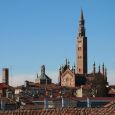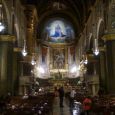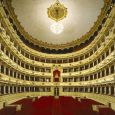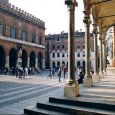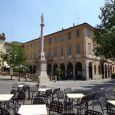Cremona
Advertisement
By Train
Cremona railway station opened in 1863 is the terminus of six railway lines all of a regional nature linking Cremona with Pavia, Mantua, Treviglio, Brescia, Piacenza and Fidenza respectively.
By Road
The city is crossed from north to State Road 10 Lower Valley with a bypass.Cremona is also an output of Highway A21 Torino - Brescia.The city also has a network of buses for urban transport (Where the bus is commonly called "Radial"), both for the long-distance connecting the city center with the villages and the surrounding municipalities.
By Ferry
Thanks to the port on the river Po the city is connected with the sea.The waterway connecting with London, open to modern cargo ships river is one of the oldest and most ambitious objectives of the waterway.The consortium in charge of construction of the Channel Milan-Cremona-Po established in 1941 was disbanded on 31 December 2000.Until now it was only built a stretch of canal that reaches Pizzighettone about 13 km long with features suitable for vessels of CEMT class V.
Cathedral of Cremona
is a vast temple Roman constantly readjusted with elements Gothic, Renaissance and Baroque. Inside is great masterpieces of sculpture and painting, including the ' tomb of Sts. Mario and Martha and their children and Audiface Abaco, martyrs in Persia called "Ark of the Persian martyrs".The cathedral was built in Cremona in the twelfth century a period of great prestige of the city connected to a series of successes in the military field conditions and economic well-being.The site chosen for construction was the highest point of the city's medieval not far from the center of the original castrum Rome sheltered by the floods of the Po which flowed at that time much closer to the center than it is today.In this place before there were two churches dedicated to St. Stephen and St. Mary which were demolished to begin construction of the main temple.The date of laying the first stone is known: 26 August 1107.
Torrazzo of Cremona
located next to the cathedral of Cremona, Lombardy is the symbol of the city.It is the tallest tower town Italy second only to the bell tower of the Cathedral of Mortlake in the province of Udine (built in the twentieth century, however, concrete).From a plaque at the base of the Cremona Torrazzo it reads the height (250 arms and two ounces of Cremona, which is about 110 meters).For more precise measurements we know that in reality is 112.27 m high with a total of 502 steps.Torrazzo derives from the name of the cake to Cremona the nougat specialty mostly typical of the holiday season.
Palace Novigrad
was built in 1265 outside the ancient Roman city.Formed together with Trecchi palace and church of St. Agatha, the new core of the expansion of the medieval city at the behest of the faction of "popular".This fact is contrasted to that of "notables" which had its center in the ancient Piazza del Comune the town hall which was imitated for the construction of the new building.The facade on the square has a facade with two floors the lower consists of a colonnade of pillars with arches gothic pillars covered with a coffered wooden roof and the upper brick and crowned with battlements arrow with four three-light windows which illuminate a single large room.Throughout the twelfth century we met the "City Council Nova.
Theatre Ponchielli
was built, designed by architect Luigi Canonica from 1806 on the ruins of the old Theatre Company which was destroyed by fire.It was named after the composer Amilcare Ponchielli in 1907.Formerly Cremona had a Rangoni Theatre / Ariberti, built in 1670 and active until 1717 when it was converted into a church, following a donation.Since then the performances took place in the temporary rooms. In 1733 a group of nobles and patricians determined to give the city a new theater.Only in 1745 the Marquis Giuseppe Lodi Mora available to put a plot in the district of St. Bartholomew, at Porta Po , while the funds were provided by the noble GB Nazari, who would become the owner.It was called 'Theatre Nazari named after the owner but changed its name in 1785 in the Theatre of the Company or of the 'Noble Association if after the death of the Marquis Nazari (1784) was purchased by a group of nobles and patricians ( a "company of twelve Knights"), who divided the property as the box-holders (in accordance with what was happening with the many theaters built up to half of the 800 ( Teatro alla Scala of Milan, the Teatro Sociale in Como, Teatro Sociale of Monza etc.).Thus ended a longstanding dispute between the owners and the box-holders which appeared as mere tenants in and complained again the high cost of the so-called is ie the fee that each box-holders was held to pay for the construction of the seasons.
Fodri Palace
is one of the most interesting examples of architecture of the Renaissance Cremona.Built by William de Lera, its construction lasted from 1488 to the beginning of 500, with the participation of artists from the school of Giovanni Antonio Amadeo, including Alberto Maffiolo from Carrara, authors in front of Portalino marble, and Rinaldo Stauris (or Staulis), collaborator dell Amadeo in the two cloisters of the Certosa di Pavia, creator of the double Order of decorations in terracotta.Two other Fodri Palace, previously unknown and rediscovered thanks to the research of Dr.Gianantonio Pisati, rise in via Beltrami (formerly Fodri Contrada della Signoria, then Contrada Ripa d Adda).The first is located at No. Civic 18 (now the newspaper "The Chronicle"), while the second (adjacent to No. 16) revealed the presence of an interesting cycle of paintings profane (the only one in Cremona) hitherto unknown came to light in 2008 thanks the renovation of an up-then-anonymous room on the ground floor.The cycle of frescoes but hitherto unknown author of the first half of the sixteenth century is the myth of Tereus, Philomela and Procne drawn from Ovid's Metamorphoses.
November - February
June - September


